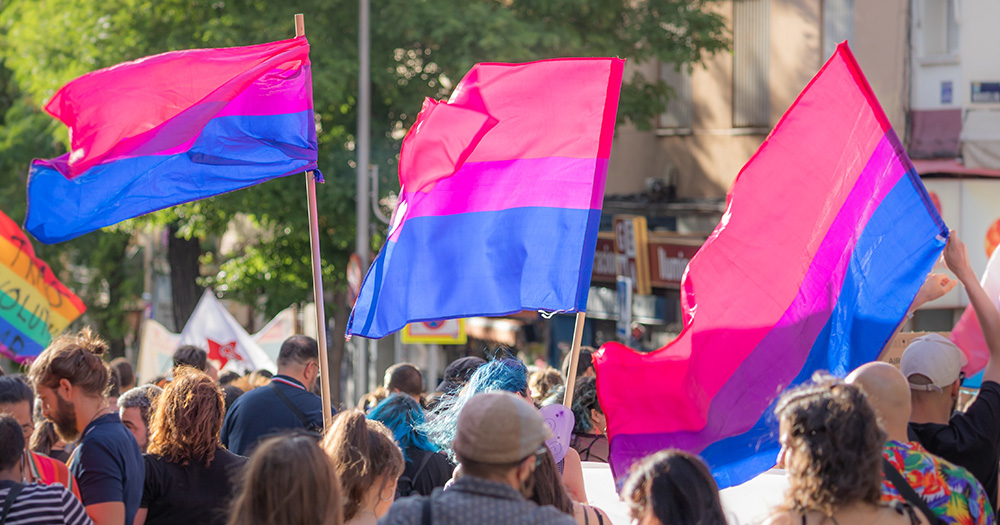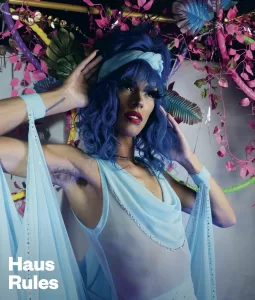With September marking Bisexual Visibility Month, Han Tiernan delves into the legacy of bi activism in Ireland. Through a retelling of the work of the trailblazing Bi Irish group, discover stories too often overlooked and erased from the history books.
It is widely accepted that the ‘B’ in LGBTQ+ is all too often silenced. This erasure lends to the loss of bisexual activism from the history books, and Ireland is by no means innocent of this offence. Aside from documents in the Irish Queer Archive and articles published in GCN, there is virtually no public record of the phenomenal legacy of Bi Irish.
While studying at UCD in 1996, friends Jane Freeman and Jude Cosgrove identified a lack of support geared towards bisexuals and so, formed their own group, Bi Irish. They were joined by like-minded individuals, including Darragh Doherty, who would later become the group chair.
Initially, the group provided a support network for people identifying as bisexual, creating a space for members to come together and share their experiences through monthly meetings held in Outhouse, first at the South William Street site and later at the current Capel Street building.
As the group expanded, it became increasingly evident that common frustrations were reoccurring. Members would speak about the misconceptions and assumptions placed on bisexuals, the general negative attitude towards bisexuality in wider society, and the impact this was having on their lives and well-being.
It was evident that the group’s remit needed to expand to include the objectives of increasing visibility and awareness.
The first initiative was to begin publishing a monthly ‘Bidentity’ column in GCN, the first of which appeared in Issue 117, May 1999. The articles covered many topics, from reporting community events to debating commonly held stereotypes and sharing members’ personal experiences. An article in Issue 142, August 2001, reported on the first European Bisexual Conference in Rotterdam in June of that year, and announced that Dublin was set to host the second edition (EBC2) in 2003.
Bi Irish also undertook an ambitious public survey to better understand the scope of misconceptions and the community’s needs. Spearheaded by Jude with support from Lar Quigley and Christine Kehoe, a comprehensive questionnaire titled ‘Bisexuality—What Do You Think?’ was distributed among all members and published in Issue 120, August 1999, of GCN to widen the scope of responses, especially in the hopes of reaching beyond Dublin.
Once the responses were gathered, Jude authored the subsequent 44-page report, Bisexuality: A Survey of Attitudes, Needs and Definitions Amongst the Irish Queer Community. Although Jude had worked voluntarily for over a year to deliver the results, the printing and design costs were covered by a grant from the Department of Social, Community, and Family Affairs, which had been applied for by Bi Irish members Ronan Waters and Louise Tierney, the then manager of Outhouse.
Ahead of EBC2 and inspired by the Rotterdam edition as well as other UK Bi Cons that many members attended annually, the group decided to host the first Irish Bi Con (IBC1) in Outhouse on July 27, 2002.
The one-day event commenced with a plenary session to launch the survey report. In her keynote speech, Jude revealed that there had been 115 respondents, with a near-even split of male to female (none of the participants had chosen to identify as transgender). According to the report, 40% identified as bisexual or bi-curious, 28% as gay, 17% as lesbian, and only 10% as straight.
As well as capturing respondents’ general attitudes towards bisexuality, the questions also covered the participants’ understanding of the sexual behaviour of bi people and the spread of HIV, none of which made for particularly uplifting results. Although the sample was considered too small to garner any “specific conclusion”, the results did provide “general indicators of complex social realities”.
The launch at IBC1 was followed by a parallel session, where attendees were offered the option of a hands-on self-defence workshop or a planning meeting in preparation for EBC2.
The afternoon sessions included a workshop to design a logo for Bi Irish and the following year’s conference, a panel discussion on drag and gender play, and an interactive discussion on the future of the bi movement in Ireland. The day finished with a social gathering downstairs at GUBU (now Pantibar).
All in all, IBC1 was deemed a success, and throughout the following year, a volunteer committee undertook the preparations for the European conference.
The conference was scheduled to coincide with Dublin Pride weekend. The committee chose ‘Loving the Difference’ as the theme to emphasise the need to “openly discuss and respect differences, both as a group of bisexual-identified and bisexual-allied people, and within the wider queer and straight communities.”
The weekend’s proceedings opened with a keynote speech delivered by leading Boston-based academic and “Grandmother of the Bisexual Movement”, Robyn Ochs. As the editor of the Bisexual Resource Guide, Robyn lectured on bisexual identity, sexual minority history and issues, and intersex, trans, and multiracial identities at Tufts University, Massachusetts.
Over the following two days, a total of 24 talks, workshops, and panel discussions occurred between Outhouse on Capel Street and the Macro Centre on Green Street. They covered a wide range of topics, such as activism, with workshops on burnout, breaking into bi journalism and creating bi-friendly spaces.
Robyn also hosted a working lunch to develop an international bisexual resource guide, while Jane held a planning session to find a new host country and organisation for EBC3.
Understandably, sexuality featured prominently with discussions around polyamory, bisexuality and intersex identities, as well as workshops analysing relationships and ‘sacred sexualities’. Hard-hitting academic subjects such as ‘Biphobia on the Gay Scene’, ‘Challenges and Opportunities for Bisexuals in Recovery from Sexual Abuse’ and tackling biphobia in legal aid were balanced with more lighthearted papers like a queer reading of Shrek, a history of bisexual characters in film, ‘Keanu Reeves and the (Heterosexual) Matrix’, and the history of dandyism.
For those who wanted a complete removal from all things sexuality, theatresports, a reality TV scriptwriting workshop, and icebreakers were a welcome antidote.
The conference had strong European representation in the form of delegates from the UK, the Netherlands, France, Spain, and Sweden. However, it also included a surprising number from further afield, with at least four from the US and even one from New Zealand.
Extracurricular activities included a ‘Bi Brother Diary Room’ hosted by filmmaker Fernando Sanchez, where participants could share their views on EBC2, bisexuality, or anything they felt the need to get off their chest.
Social events also played a crucial part in bringing the delegates and attendees together. The opening night set the tone with a wine reception following the keynote speech.
However, Saturday night provided the social highlight of the weekend with EBC’s second birthday party. After marching in the Pride parade, Bi Irish hosted a faux-fetish night in the basement of Viva on South William Street with entertainment from three DJs and prizes awarded for the best dressed.
On Sunday, the weekend closed with a warm and intimate dinner held in Ciao Bella Roma on Parliament Street.
Despite the overwhelming success of EBC2, over the following months, several senior members of Bi Irish stepped down, including Jude, Jane and Darragh. Most were due to work and life circumstances, but the pressures of organising such an ambitious event had taken their toll. The remaining members continued to run monthly meetings for several years, but unfortunately, the group ran its course by the mid-2000s.
Whilst Bi Irish has been replaced by the worthy successor, Bi+ Ireland, formed in 2012, the legacy those trailblazing activists left cannot be forgotten. As bi-erasure continues to be a challenge in the LGBTQ+ community and wider society, their tireless dedication paved the way for the progress in visibility and rights that we see today.
© 2024 GCN (Gay Community News). All rights reserved.
This article was published in the print edition Issue No. 385 (August 1, 2024). Click here to read it now.
Support GCN
GCN is a free, vital resource for Ireland’s LGBTQ+ community since 1988.
GCN is a trading name of National LGBT Federation CLG, a registered charity - Charity Number: 20034580.
GCN relies on the generous support of the community and allies to sustain the crucial work that we do. Producing GCN is costly, and, in an industry which has been hugely impacted by rising costs, we need your support to help sustain and grow this vital resource.
Supporting GCN for as little as €1.99 per month will help us continue our work as Ireland’s free, independent LGBTQ+ media.

